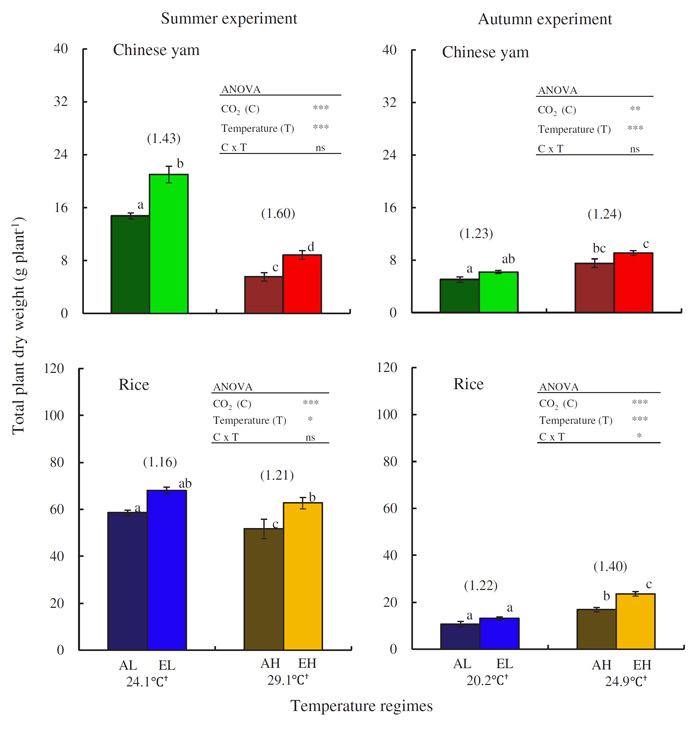| Follow @co2science |
Paper Reviewed
Thinh, N.C., Shimono, H., Kumagai, E., and Kawasaki, M. 2017. Effects of elevated CO2 concentration on growth and photosynthesis of Chinese yam under different temperature regimes. Plant Production Science 20: 227-236.
Writing as background for their work, Thinh et al. (2017) note that yam is "the third most important tropical root and tuber crop after cassava and sweet potato in west Africa, central America, the Pacific islands, and southeast Asia," yet few are the studies that have been conducted on how it might respond to the potential effects of climate change. Therefore, it was the objective of this team of four researchers to study the interactive effects of temperature and CO2 on the growth of Chinese yam (Dioscorea opposita Thunb., cv. Enshikei 6), which effects they then compared to the response of a more common crop, rice (Oryza sativa, cv Hitomebore), growing under identical conditions.
The experiments were conducted indoors during both the summer and fall seasons under controlled environment conditions at the Tohoku Agricultural Research Center in Morioka, Japan. Daytime CO2 concentrations averaged 403 ppm in the ambient and 598 ppm in the enriched chambers during the summer experiment, and 400 and 591 ppm in the ambient and elevated chambers during the fall experiment, respectively. Ambient temperature conditions were designed to follow the outside air temperature and averaged 0.3°C higher than the outside air over the course of the experiment. In the high temperature treatment, temperatures were maintained at values 5°C higher than the ambient chambers. The summer experiment began on 11 July and lasted 55 days, while the fall treatment began on 23 August and lasted 42 days.
Results of the experiments revealed that in the ambient temperature treatment, elevated CO2 increased the number of leaves, vine length, leaf area, leaf dry weight, vine dry weight, root dry weight, tuber dry weight and total dry weight of Chinese yam by 29, 49, 59, 61, 59, 38, 44 and 43 percent, respectively. Similar or greater CO2-induced enhancements were witnessed in the high temperature treatment of Chinese yam, which saw increases in these same parameters of 54, 86, 71, 76, 67, 83, 40 and 60 percent. In the fall experiment, the percentage increases of these growth parameters in Chinese yam due to elevated CO2 were somewhat muted and mostly nonsignificant at both ambient and high temperatures. However, the total dry weight differences at ambient and high temperatures were significantly enhanced under elevated CO2 by 23 and 24 percent, respectively.
Rice crops also benefited from higher atmospheric CO2 concentrations. Total dry weights were 16 and 21 percent higher in the ambient and high temperature treatments during the summer and 22 and 40 percent higher in the fall experiment, respectively. Collectively, therefore, such findings demonstrate that elevated CO2 positively impacts the growth response of these two crops, and at similar or greater percentages at higher temperatures. Thus, we can expect significant yield enhancements of these two important food crops in the future. And that is wonderful news!

Figure 1. Effects of elevated CO2 concentration on total plant dry weight in Chinese yam and rice. Different letters indicate significant differences at the 5% level. Bars show mean ± SE, AL: ambient CO2-low temperature, EL: elevated CO2-low temperature, AH: ambient CO2-high temperature, EH: elevated CO2-high temperature. Numbers in parentheses are ratios of values under elevated CO2 to those under ambient CO2. †mean air temperature, ***p<0.001, **p<0.01, *p<0.05, ns: not significant. Source: Thinh et al. (2017).




